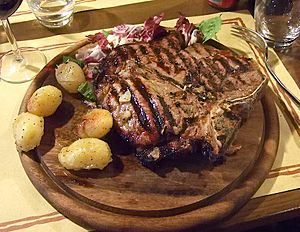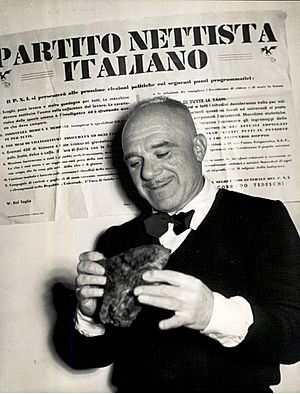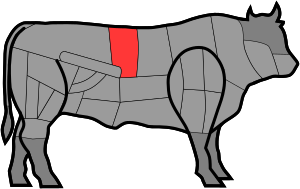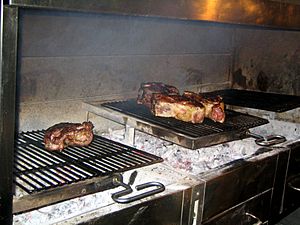Bistecca alla fiorentina facts for kids
 |
|
| Alternative names | beefsteak Florentine style |
|---|---|
| Place of origin | |
| Region or state | Tuscany |
| Associated national cuisine | Italian cuisine |
| Cooking time | 11 minutes to 17 minutes |
| Serving temperature | hot |
| Main ingredients | beef meat |
The bistecca alla fiorentina (which means "beefsteak Florentine style") is a famous Italian steak. It comes from young beef cattle and is prepared in a special way. This makes it one of the most popular dishes from Tuscany, a region in Italy.
This steak is a thick cut of meat that includes the bone. It's usually cooked over hot embers or on a grill. It's often served "al sangue," which means it's still quite rare or "bloody" inside.
Contents
History of Florentine Steak
The story of the Florentine steak is very old. It goes back to the city of Florence in Italy, where it gets its name. No one knows exactly when it started. But its tradition and name are linked to the feast of Saint Lawrence on August 10th. This celebration also involves the powerful House of Medici, a famous family from Florence.
How the Steak Became Famous
During the Festa di San Lorenzo, the city of Florence would light up with big bonfires. Large amounts of veal (meat from young cows) were roasted on these fires. Then, this meat was given out to everyone in the city.
Florence was a busy place during the time of the Medici family. Many travelers from all over the world visited the city. It is said that some English knights were there for the Saint Lawrence celebration. They were offered the roasted meat. They called it "beef steak" in their language. From this, the Italian word bistecca was created. This is the word we still use today.
Another Idea for the Name
Another story says the name came from the English people who lived in Florence in the 1800s. These were often wealthy people. They could afford expensive cuts of meat, like beef steak. They also enjoyed roast beef, which is another dish found in Florentine cooking.
The Steak Party
In the 1950s, a publisher from Florence named Corrado Tedeschi started a political group. It was called the Italian Nettist Party, but people knew it better as the Steak Party (Partito della Bistecca). This party was seen as a funny or satirical group. It took part in the 1953 Italian general election. Their main slogan was "Better a steak today than an empire tomorrow." They even promised to give everyone a 450-gram steak every single day!
What Makes a Florentine Steak?
The Florentine steak comes from a specific part of the cow. It's cut from the sirloin area. This is the part of the back near the tail. The meat usually comes from a special type of cow called the Chianina breed.
The "T" Bone
In the middle of the steak, there's a bone shaped like a "T". This is why it's also called a T-bone steak. On one side of the bone, you'll find the fillet (a very tender part). On the other side is the sirloin.
Famous Definitions
An Italian food expert named Pellegrino Artusi wrote a cooking book in 1891. He described the Florentine steak. He said the word "steak" came from the English "beef-steak." He explained that it's a chop with its bone, about one to one-and-a-half fingers thick. It's cut from the sirloin of a young cow.
Corrado Tedeschi, the person who started the Steak Party, also had his own definition. He said that for a steak to be a true Florentine steak, it must weigh at least 450 grams. He joked that if it weighs less, it's just a cutlet, and then his party wouldn't be the "Beefsteak Party" anymore!
How to Prepare Florentine Steak
First, the meat needs to be "aged" for at least two weeks in a cold room. This helps make it more tender. Before cooking, the steak should be at room temperature. A typical steak weighs about 1 to 1.5 kilograms and is about 5 to 6 centimeters thick.
Grilling the Steak
To cook it, you need a good amount of hot charcoal embers. Oak or olive wood charcoal is often preferred. The coals should be very hot, with just a light layer of ash, and no flames. It's important to avoid using gas grills or electric grills.
The meat should first be placed very close to the hot coals. This helps create a tasty crust quickly. This process is called the Maillard reaction. After about one minute, the steak should be moved to a slightly cooler part of the grill.
Cooking Times
You should put the meat on the grill without any seasoning first. This helps keep it from getting tough. Turn the steak only once. Cook it for about 3 to 5 minutes on each side.
Finally, the steak should be cooked standing up on the bone side. The steak needs to be thick enough to stand on its own. Cook it like this for about 5 to 7 minutes. You'll know it's ready when you don't see any "blood" (which is actually a protein called myoglobin) coming from the bone. However, some chefs believe the meat should not be cooked standing up.
The Secret to Taste
Good cooking is key to the delicious taste of this dish. The outside of the meat should be nicely browned. But the inside should be red, soft, and juicy. It should be warm, but not fully cooked through.
It's important not to use forks or other tools that can poke holes in the meat. This can break the crust that forms. It can also cause the tasty "juices" to leak out. Instead, gently turn the steak with a proper tool that won't pierce it.
Another Way to Cook It
There's another cooking method called "reverse searing." With this method, you first heat the steak slowly. You can do this in a barbecue or a regular oven. The goal is to get the center of the meat to about 50°C (122°F).
After that, you place the steak on a very hot grill or pan. A cast iron pan works well. This quickly creates a brown, tasty crust using the Maillard reaction. Finally, let the steak rest for 4 to 5 minutes before serving. When you cut it, try to slice against the grain of the meat.
What to Serve With It
Traditionally, Florentine steak is served with cannellini beans. These beans are usually dressed with olive oil. A simple salad also goes well with it. You should not put lemon juice on the steak. For drinks, a good red wine like Chianti classico is often suggested for adults.
See also
 In Spanish: Bistecca alla fiorentina para niños
In Spanish: Bistecca alla fiorentina para niños





